The Great Wildebeest Migration – An Ultimate Guide

The Great Wildebeest Migration is a supreme wildlife phenomenon that unfolds every year in Tanzania’s Serengeti and Kenya’s Masai Mara reserves. Triggered by the seasonal rains, millions of wildebeest, lakhs of zebra and hundreds of thousands of antelope migrate in search of fresh grazing grounds. Along the way, they make traitorous river crossings where crocodiles are waiting to kill and many fall prey to other predators like lions, leopards and cheetahs. But do you known when do the river crossings take place and when is the best time to see the migration in action?
Contrary to what many people think, the Great Wildebeest Migration doesn’t only take place between July and September. This is the time when the nerve-racking river crossings occur, for which the migration in Masai Mara is most famous for. Rather, the Great Migration is a year-round and ongoing mass movement of wildlife. Driven by the rains in East Africa, millions of wildebeest, zebra and antelope embark on a extreme quest to find good grazing and return to the southern plains of the Serengeti for the annual calving season.
The never-ending mass migration

The Great Migration takes place in the Serengeti-Mara ecosystem covering Tanzania and Kenya. The mass migration is a clockwise movement where the journey starts after the calving season in the Ndutu region and the southern plains of the Serengeti National Park. The herds then move to the Grumeti region of the Serengeti National park moving northwards and westwards. After crossing the Grumeti River, they move further north towards Kenya’s Maasai Mara National park which borders the Serengeti to the north. Mara river crossing is the most famous amongst the several rivers they cross along their journey. The wildebeest stay in the Mara for the period of July to September before circling back south and migrating down to the fertile southern plains of Serengeti to give birth.
To predict the exact timing of the animals’ movements is very tricky. If you book an East African safari in peak safari season between July and September thinking that you will witness one of the world-famous river crossings, then let me apprise you that there is no guarantee you’ll get to see one. Nature is very unpredictable and there’s no way that we can accurately forecast exactly where the herds will be, if the rains are going to be as per forecast, or how long they’re going to last. The rains can’t be predicted as it may come early one year and delayed the next.
Even if you do happen to be at the spot on time and you’re positioned perfectly next to the river to watch a dramatic river crossing, the migration would still remain unpredictable. Sometimes, the mega herds stay gathered on the river banks for days before they even attempt a river crossing. And sometimes, the animals cross and follow as soon as they arrive near the water. For this reason, if your ultimate goal is to witness a river crossing then it’s important to factor in as much time on safari as possible.
However, River crossing is just a part of the Great Migration and there’s more to it. Calving season is another equally exciting phenomenon of this age-old migratory cycle.
But its also important to know that the Serengeti and Masai Mara resident game is abundant with the wildlife sightings and is so rewarding that you can go on safari at any time of year, even during the non-migration season, and still you can have an excellent game viewing experience. Here’s an ultimate guide of what tends to happen and when:
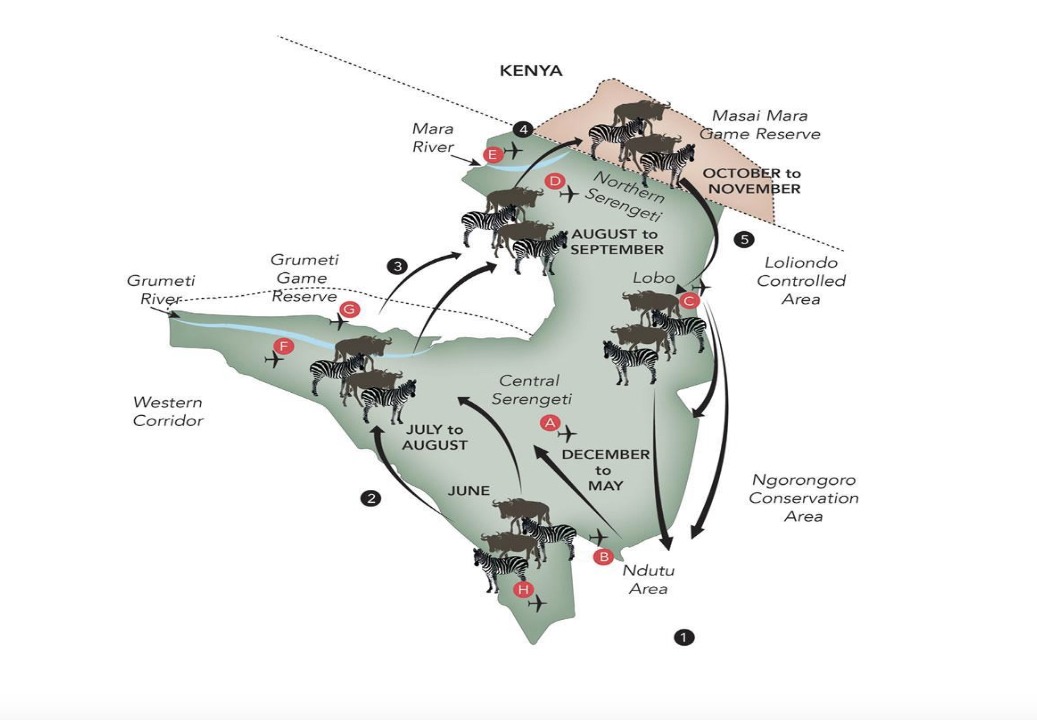
The migration map explained:
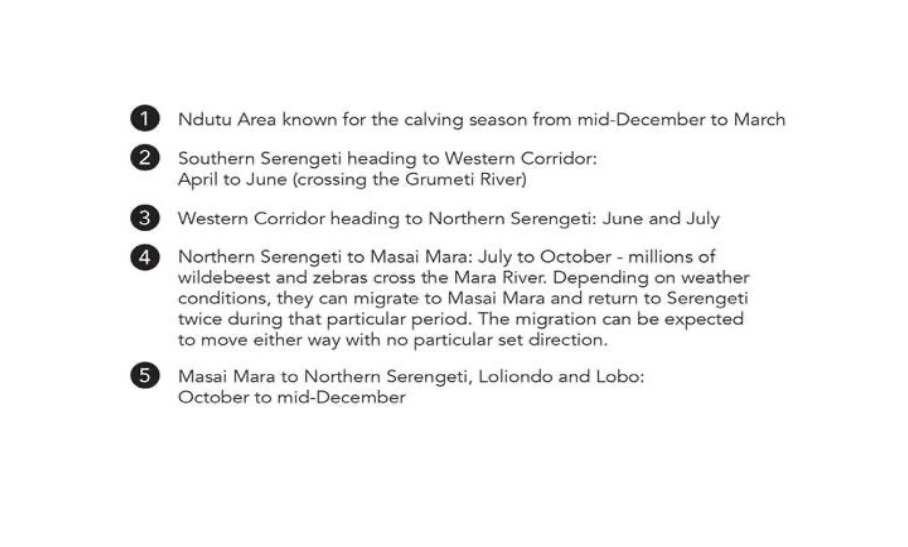

The Greatest Show on Earth
It’s easy to understand why the annual migration of millions of wildebeest and scores of zebra on the vast plains of East Africa is often referred to as The Greatest Show on Earth. Nothing can really prepare you for the full impact of the drama that would unfold when you are actually going to witness it in front of you.
The wild sound of thundering hooves and churning water. The harried sight of hordes of wildebeest quickly trying to get to dry land on the other side of the river. The petrifying odds of falling prey to crocodiles lying immersed in the water and big cats waiting for the right moment to strike.
On the other hand one can witness the equally dramatic calving season on the southern plains of the Serengeti and Ndutu region in Tanzania between January and March. The sight of the shaky legs of the newborn wildebeest calves trying to stand and Predators waiting to ambush them.
We feel privileged to have witnessed the one-of-a-kind experience that the Great Wildebeest Migration can offer. We can with great enthusiasm say that a Serengeti or Masai Mara migration safari should on your bucket list, if it is not yet there!
Now sharing a chart to showcase various seasons and animal movement guided by rains, where you go and when you go on safari depends on which events you’d like to witness.
| What | When | Where |
| Calving Season | January – Mrch | Ndutu & Southern Serengeti |
| Rutting Season | April – June | Western & Central Serengeti |
| Mara River Crossing | July – September | Northern Serengeti & Masai Mara |
| On the move | October – December | Masai Mara & Northern to Southern Serengeti |
The Serengeti and Masai Mara’s incredible wildlife and endless vistas make them wonderful year-round safari destinations
If you’re keen to experience a Great Migration safari, contact us for a free quote. Remember to let us know when you’d like to travel and what part of the migration you’d like to experience.
Book Now
Recommended Tour
15 Days Highlights Of Tanzania & Kenya
On this comprehensive introduction to East Africa, you get to observe the abundant and diversified wildlife of Tanzania and Kenya. Stay in comfortable, spacious lodges with ideal locations in the region’s…
10 Days Kenya Wildlife & Birdwatching
When the word “safari” is uttered, the image that comes to mind is the traditional aura of comfort in the wilderness, of huge open plains filled with every manner of wild beast, and it’s a must for anyone interested…
6 Days Masai Mara – The Great Migration Experience
An absolute paradise for wildlife enthusiasts, Masai Mara exhibits the most thrilling and fascinating display of wildlife behaviour. The great wildebeest migration is situated in the plains of East Africa and comes as an…



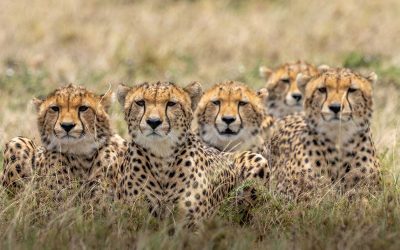
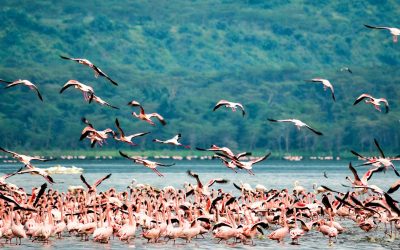
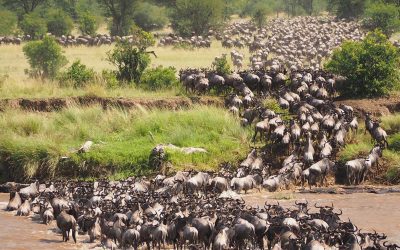
0 Comments